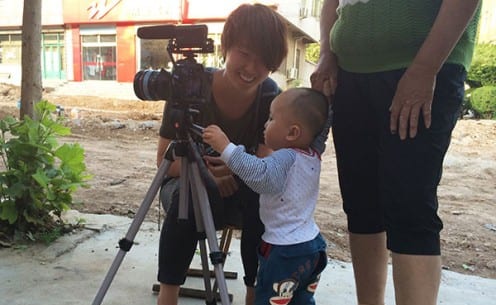Filmmaking and photography in anthropological research
By Tom McDonald, on 12 June 2014

Child in north China fieldsite explores Kiki Wang’s camera (Photo: Tom McDonald)
As part of the project’s ambitious plans for telling people about the findings of our research, I’m fortunate to have been able to collaborate with the incredibly talented and creative Gillian Bolsover and Kiki Wang who have just finished a short visit to the north China fieldsite, in order to produce a series of photographs and films with the aim of bringing the ethnography to life for people all around the world.
It’s been a particularly intensive week of work for us all, as I have been taking both of them around many places in the fieldsite, trying to introduce them to as many of my friends here as possible and to help them to capture as many different aspects of life in the town and villages as we can.
But I’ve found the exercise to be useful in another sense; it has forced me to reflect on the key relationships and friendships that I have made with people in the town during the past year of fieldwork. These people have been both great and wonderfully understanding about participating in our photos and films. I had assumed that they would be reticent about the process, but often they have been really positive about appearing in the films and see it as a chance to tell people around the world about their hometown and their lives. Traditional anthropological papers and books have always attempted to tell the stories of ‘faraway others’, but it is a shame that so few people tend to read ethnography. I hope that through these photos and videos I can bring the lives of the people in our fieldsite who have been so generous in participating in this project to more people and in different formats.
Having two fresh pairs of eyes in my fieldsite has also helped in other ways. Speaking with Gillian and Kiki over the past week and hearing their opinions on my fieldsite has made me reconsider aspects of my own ethnography and many times they have asked my research participants questions that I had never thought of.
It will take some time for the final results to be ready; however, what I have seen so far suggests they will be a success in every way. The entire experience of working with photographers and filmmakers has confirmed my belief in the value of collaborative anthropological research projects, which draw on the skills of people from all kinds of backgrounds. Before last week I was hesitant about conducting research that involved taking photos and making films, but now I honestly can’t imagine doing research without it.
 Close
Close






